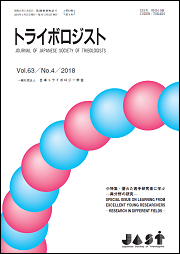Volume 69, Issue 12
Special Issue on Recent Analysis Technologies of Sliding Surface
Displaying 1-15 of 15 articles from this issue
- |<
- <
- 1
- >
- >|
Announcement
-
2024Volume 69Issue 12 Pages K12
Published: December 15, 2024
Released on J-STAGE: December 15, 2024
Download PDF (614K)
Contents
-
2024Volume 69Issue 12 Pages M12
Published: December 15, 2024
Released on J-STAGE: December 15, 2024
Download PDF (254K)
Special Issue on Recent Analysis Technologies of Sliding Surface
-
2024Volume 69Issue 12 Pages 779
Published: December 15, 2024
Released on J-STAGE: December 15, 2024
Download PDF (178K)
Explanation
-
2024Volume 69Issue 12 Pages 780-785
Published: December 15, 2024
Released on J-STAGE: December 15, 2024
Download PDF (1465K) -
Analysis of Molecular Adsorption Structures on Sliding Surface Using Non-Linear Optical Spectroscopy2024Volume 69Issue 12 Pages 786-791
Published: December 15, 2024
Released on J-STAGE: December 15, 2024
Download PDF (1441K) -
2024Volume 69Issue 12 Pages 792-797
Published: December 15, 2024
Released on J-STAGE: December 15, 2024
Download PDF (1746K) -
2024Volume 69Issue 12 Pages 798-803
Published: December 15, 2024
Released on J-STAGE: December 15, 2024
Download PDF (2976K) -
2024Volume 69Issue 12 Pages 804-809
Published: December 15, 2024
Released on J-STAGE: December 15, 2024
Download PDF (2271K) -
2024Volume 69Issue 12 Pages 810-815
Published: December 15, 2024
Released on J-STAGE: December 15, 2024
Download PDF (2283K)
Up-to-date News Tribo-Episode -Tribo-Technology Award-
-
2024Volume 69Issue 12 Pages 816-817
Published: December 15, 2024
Released on J-STAGE: December 15, 2024
Download PDF (4472K)
Up-to-date News Tribo-Episode -Award for Student Tribologists-
-
2024Volume 69Issue 12 Pages 818-819
Published: December 15, 2024
Released on J-STAGE: December 15, 2024
Download PDF (4016K) -
2024Volume 69Issue 12 Pages 820-821
Published: December 15, 2024
Released on J-STAGE: December 15, 2024
Download PDF (3990K)
Original Contribution on Science
-
2024Volume 69Issue 12 Pages 822-832
Published: December 15, 2024
Released on J-STAGE: December 15, 2024
Advance online publication: September 10, 2024Download PDF (3000K)
Report of the Society
-
2024Volume 69Issue 12 Pages 833-841
Published: December 15, 2024
Released on J-STAGE: December 15, 2024
Download PDF (3835K)
Index to Volume 69
-
2024Volume 69Issue 12 Pages M-69
Published: December 15, 2024
Released on J-STAGE: December 15, 2024
Download PDF (539K)
- |<
- <
- 1
- >
- >|
